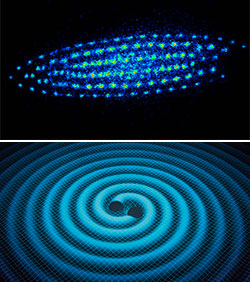Upward Trajectory
Northwestern University’s Physics and Astronomy Department is rising in impact and visibility
Over the last 15 years, Northwestern’s Department of Physics and Astronomy has emerged as a force in the field, with new researchers pushing innovative projects, compelling collaborations and groundbreaking discoveries that have elevated the standing and reach of the department.
“The possibilities for Physics and Astronomy seem much broader and much greater than I imagined when I came here [in 2000],” confirms professor and department chairman Michael Schmitt.
Indeed, everything and anything seems possible today.
Thanks to the continued support of Weinberg College and Northwestern leadership, standout researchers continue to join the department’s faculty, including the likes of Enectalí Figueroa-Feliciano, a former MIT professor who conducts innovative research on X-ray astronomy, dark matter and neutrino physics, as well as supernovae expert Raffaella Margutti.
Next year, renowned physicist Gerald Gabrielse, a longtime Harvard professor and leader in super-precise measurements of fundamental particles and the study of anti-matter, will make the move to Northwestern and launch the Center for Fundamental Physics at Low Energies.
Pioneering efforts
Department faculty are also taking leadership roles in pioneering efforts.
In Puerto Rico, for instance, Professor Mayda Velasco is leading the establishment of COFI — the Colegio de Física Fundamental e Interdiciplinaria de las Ámericas, a new center aiming to propel new partnerships with scientists in Latin America and Brazil. Meanwhile, Venkat Chandrasekhar and colleagues in condensed matter physics are working with Fermilab to form a new Center for Accelerator Physics and Superconducting Technology, a collaborative effort that will drive cutting-edge research projects in superconducting accelerator technology.
“We have so many researchers making bold plans and thinking big,” Schmitt says.
In recent years, the department’s astronomy arm has become recognized as one of the nation’s foremost centers for astronomical research activity. The research group of Vicky Kalogera, the E. O. Haven Professor of Physics and Astronomy, for example, played a prominent role in the LIGO Scientific Collaborative’s recent discovery of colliding black holes and gravitational waves — something Einstein astutely predicted a century ago.
“We hit the scientific jackpot here, and it’s opened up an entirely new way of observing and understanding the cosmos,” says Kalogera, who led the astrophysical interpretation of the discovery for the LIGO Collaborative, a far-ranging scientific effort that includes nearly 1,000 researchers.
At the forefront
Now as one of the nation’s very few universities with both a LIGO group and a team that studies “transient astronomy” — the exploration, Kalogera says, “of things that literally go boom in the universe” — Northwestern is well positioned to continue its run as a national leader, especially as the National Science Foundation has identified multi-messenger astronomy and gravitational waves as one of the agency’s top priorities.
“We will be at the forefront of an exploding field and have an opportunity to take another major step forward,” says Kalogera, the department’s associate chair who also directs Northwestern’s Center for Interdisciplinary Exploration and Research in Astrophysics (CIERA).
All of the momentum combined with renewed, steady support from Weinberg College and Northwestern University has Schmitt and his department colleagues energized for what lies ahead.
“This department has turned a corner and entered a period of growth and accomplishment,” Schmitt says, “and I am certain that more great things are coming.”
Back to top